Aardvark
Posted on April 12, 2018 at 5:27 pm
B| Lowest Recommended Age: | Mature High Schooler |
| MPAA Rating: | Rated PG-13 for mature thematic issues, language, some sexuality and violence |
| Profanity: | Some strong language |
| Alcohol/ Drugs: | Some drinking, references to psychotropic medication |
| Violence/ Scariness: | Some violence, character injured, references to sad deaths |
| Diversity Issues: | None |
| Date Released to Theaters: | April 13, 2018 |

“Aardvark” has three thoughtful performances and a couple of intriguing interactions, but is ultimately undermined by an underwritten script. The parts are greater than the whole.
Zachary Quinto, who also produced, plays Josh, and we meet him on his first visit to a new therapist, which conveniently gives us a chance to learn very quickly that (1) he is underemployed in a coffee shop but sees it as progress so he must have been pretty badly off, (2) he has plenty of money, but keeps it crumpled up in his pocket so does not seem too on top of things, and (3) he has a brother who — he says — is a successful and very talented actor named Craig, and who is back in their home town for the first time in many years.
Josh is clearly fragile, but is he an unreliable narrator? Should we believe him? The new therapist, Emily (Jenny Slate) is not sure, and neither are well. Josh emphasizes that his brother is such a gifted actor that he can appear as anyone. In a couple of exceptional scenes, Josh speaks to an older homeless white woman and a black cop, who — are we seeing into his mind? — turn out to be Craig.
Is there a Craig? Is he anything like Josh’s description? We probably have concluded it is unlikely as perhaps Emily has, too, until he does, in fact, show up at Emily’s door, played by Jon Hamm. And this is where the movie starts to run out of ideas.
Slate gives an underwritten character as much depth as possible, and two intriguing encounters suggest that perhaps there were other versions of the story that provided more background (or should have). It is disappointing that writer/director Brian Shoaf could not come up with a less well-worn set of conflicts for her. Hamm continues to be one of today’s most thoughtful and adept performers. Especially in his early scenes, Hamm is able to show us the personality distortion of Craig’s years of semi-stardom (as the lead in a popular television series) and distance from his home and his brother. And Quinto is perceptive as he portrays Josh in different stages of his illness, with and without medication.
It is very good to see a movie about someone with mental illness who is not portrayed as cute or a savant, and especially good to see one that grapples with the survivor guilt and exhaustion of family members. Shoaf shows some promise as a writer and director and we look forward to what he comes next.
Parents should know that this movie’s themes include severe mental illness and psychotropic medications, references to sad loss of family members, some violence, strong language, sexual references and situation
Family discussion: Why didn’t Craig want to see Josh? What did Josh miss when he was taking his medication?
If you like this, try; “Entanglement,” “It’s Kind of a Funny Story” and “The Perks of Being a Wallflower”
